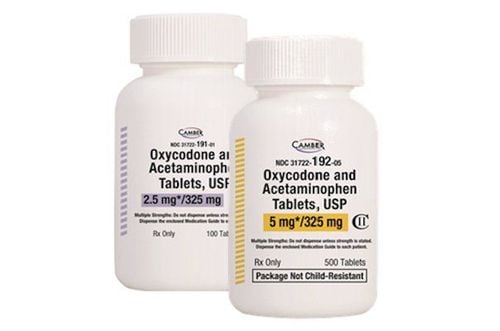This is an automatically translated article.
OxyContin belongs to the group of narcotic analgesics and is used in the treatment of moderate to severe pain in patients. Let's learn about the use of OxyContin 15mg through the article below.1. What is OxyContin 15mg?
1.1 Drug ingredients OxyContin Main active ingredient: Oxycodone hydrochloride.
Excipients: Lactose monohydrate, Povidone, Copolymer ammoniomethacrylate, Sorbic acid, Glycerol triacetate, Stearyl alcohol, Talc, Magnesium Stearate, Hypromellose (E464), Titanium Dioxide (E171), Macrogol, Hydroxypropylcellulose and Iron Oxide (E172),..
1.2 Effect of OxyContin 15mg Active ingredient Oxycodone inside OxyContin is a drug belonging to the Opioid group of narcotic pain relievers, with similar effects to Morphine.
Oxycodone, after being administered, immediately releases and binds to receptors in the brain and spinal cord of the patient, thereby blocking pain signals and preventing pain from occurring.
2. Indications of OxyContin 15mg
OxyContin 15mg is prescribed by a specialist. Usually OxyContin is indicated for the following cases:
Treatment of moderate to severe pain. Alternative treatment when other methods of pain relief are not sufficient.
3. Contraindications OxyContin 15mg
OxyContin 15mg is contraindicated for:
People who are sensitive to Oxycodone or any of its excipients. The patient has a history of allergy to other narcotic drugs such as: Lortab, methadone, Darvocet, Vicodin, Morphine and Percocet,... The patient is diagnosed with confirmed or suspected paralytic ileus and gastrointestinal obstruction; Patients with severe respiratory failure; Patients with acute bronchial asthma, COPD or other respiratory disorders; Patients with moderate to severe liver failure; Patients with arrhythmias and high CO2 levels in the blood; Patients with prolonged (chronic) constipation; Patients with galactose intolerance, total lactase deficiency.
4. OxyContin 15mg . side effects
During the use of OxyContin 15mg, patients may experience some common side effects as follows:
Immune system disorders: Hypersensitivity and anaphylactic reactions; Metabolism and nutrition disorders: Decreased appetite; Psychiatric disorders: Anxiety, confusion, depression, insomnia, stress, abnormal thinking, euphoria and hallucinations,...; Nervous system disorders: Drowsiness, dizziness, headache, tremor and coma,..; Respiratory disorders: Shortness of breath, bronchospasm, and decreased cough. Digestive system disorders: Constipation, nausea, vomiting, abdominal pain, diarrhea, dry mouth, indigestion can cause increased liver enzymes; Skin disorders: Itching and rash; Some other side effects: urinary retention, ureteral spasm, erectile dysfunction, weakness, fatigue and low blood pressure. The symptoms mentioned above may be incomplete because each patient is different and the incidence of side effects can be massive or single. Therefore, please inform your doctor immediately about the side effects you experience for timely treatment.
5. Dosage - How to take OxyContin 15mg
5.1 How to use OxyContin 15mg is taken with or without food, the dose is 12 hours apart. OxyContin should be swallowed whole. Patients should not break, chew or crush the medicine when using. One tablet can be used at a time to reduce the risk of choking or difficulty swallowing. Patients should take the medicine with enough water to use, avoid using grapefruit juice or eating grapefruit when taking the drug. 5.2 Dosage The dosage of Oxycodone should depend on the severity of the pain and the patient's history of pain medication use. Dosage reference is as follows:
Use OxyContin as the first Opioid analgesic: 10mg/time/12 hours. Treatment of conversion from oral morphine: 10mg once every 12 hours (10mg Oxycodone is equivalent to 20mg Morphin). Treatment of pain from oral to injectable Oxycodone: Use the ratio of 2mg orally = 1mg by injection. Treatment of pain in the elderly: No dose adjustment is required, although the clearance of Oxycodone in the elderly is slightly reduced. Withdrawal of Oxycodone: Patients should be gradually reduced dose, avoid dependence and should not stop Oxycodone suddenly. Dosage is prescribed and adjusted by the doctor. Therefore, the patient should adhere to the treatment regimen of the specialist.
6. OxyContin 15mg . drug interactions
Patients should inform their doctor about the drugs or supplements they are using so that the doctor can give advice on safe drug interactions. Usually, OxyContin 15mg may interact with drugs and substances as follows:
Using Oxycodone with sedatives such as benzodiazepines or related drugs will increase the risk of sedation, respiratory depression, coma and death due to additive CNS depressant effects. Concomitant use of oxycodone with serotonin agents (SSRIs or SNRIs) can cause serotonin toxicity. Oxycodone in combination with anticholinergics or drugs with anticholinergic activity (eg, tricyclic antidepressants, antihistamines, antipsychotics, muscle relaxants, and antiparkinsonian drugs) may increase antiparkinsonian side effects. cholinergic. Do not combine Oxycodone with MAO inhibitors; Avoid using Alcohol with Oxycodone; CYP3A4 inhibitors (clarithromycin, erythromycin, and telithromycin), azole antifungals (ketoconazole, voriconazole, itraconazole, and posaconazole), protease inhibitors (boceprevir, ritonavir, indinavir and grapefruit, salfinavir), fruit juices may cause silencers oxycodone excretion and may increase oxycodone plasma concentrations; Drugs that inhibit CYP2D6 activity (eg, paroxetine and quinidine) may decrease the clearance of oxycodone, leading to increased plasma oxycodone concentrations.
7. OxyContin 15mg . overdose
OxyContin overdose can cause respiratory depression, prolonged drowsiness, unconsciousness, coma, skeletal muscle weakness, pupil constriction, pulmonary edema, bradycardia, decreased blood pressure, airway obstruction, noise Atypical snoring even increases the risk of death
Treatment of oxycodone overdose should prioritize airway re-establishment, use of oxygen support, vasopressors and treatment of circulatory shock. In case of cardiac arrest, life support techniques should be performed. People around need to quickly contact 911 or the nearest hospital for timely support.
8. Precautions while using OxyContin 15mg
During the use of Oxycodone, patients should note the following issues:
Long-term use of OxyContin may increase the risk of addiction. People who drive, operate machinery, or do concentrated work should use caution when using Oxycodone. To prevent constipation, patients can take laxatives as directed and combine a high-fiber diet and exercise. Pregnant and nursing women should consult their doctor before using Oxycodone. Use of Oxycodone for children under 18 years of age should consult a specialist. Oxycodone can be dependent on the drug. Store the drug at a temperature not exceeding 30 degrees Celsius. The article has provided information on what Oxycodone is, dosage and notes when using. To ensure safety for your health and maximize the effectiveness of your treatment, you need to take Oxycodone exactly as directed by your doctor. Store Oxycodone in a dry place and the temperature does not exceed 30 degrees Celsius.
Please dial HOTLINE for more information or register for an appointment HERE. Download MyVinmec app to make appointments faster and to manage your bookings easily.













